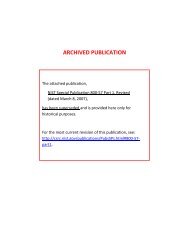NISTIR 7298 Revision 1, Glossary of Key Information Security Terms
NISTIR 7298 Revision 1, Glossary of Key Information Security Terms
NISTIR 7298 Revision 1, Glossary of Key Information Security Terms
You also want an ePaper? Increase the reach of your titles
YUMPU automatically turns print PDFs into web optimized ePapers that Google loves.
NIST IR <strong>7298</strong> <strong>Revision</strong> 1, <strong>Glossary</strong> <strong>of</strong> <strong>Key</strong> <strong>Information</strong> <strong>Security</strong> <strong>Terms</strong><br />
Role-Based Access Control –<br />
(RBAC)<br />
A model for controlling access to resources where permitted actions<br />
on resources are identified with roles rather than with individual<br />
subject identities.<br />
SOURCE: SP 800-95<br />
Access control based on user roles (i.e., a collection <strong>of</strong> access<br />
authorizations a user receives based on an explicit or implicit<br />
assumption <strong>of</strong> a given role). Role permissions may be inherited<br />
through a role hierarchy and typically reflect the permissions needed<br />
to perform defined functions within an organization. A given role<br />
may apply to a single individual or to several individuals.<br />
SOURCE: SP 800-53; CNSSI-4009<br />
Root Certification Authority – In a hierarchical Public <strong>Key</strong> Infrastructure, the Certification<br />
Authority whose public key serves as the most trusted datum (i.e., the<br />
beginning <strong>of</strong> trust paths) for a security domain.<br />
SOURCE: SP 800-32; CNSSI-4009<br />
Rootkit – A set <strong>of</strong> tools used by an attacker after gaining root-level access to a<br />
host to conceal the attacker’s activities on the host and permit the<br />
attacker to maintain root-level access to the host through covert<br />
means.<br />
SOURCE: SP 800-61; CNSSI-4009<br />
Round <strong>Key</strong> – Round keys are values derived from the Cipher <strong>Key</strong> using the <strong>Key</strong><br />
Expansion routine; they are applied to the State in the Cipher and<br />
Inverse Cipher.<br />
SOURCE: FIPS 197<br />
Rule-Based <strong>Security</strong> Policy – A security policy based on global rules imposed for all subjects.<br />
These rules usually rely on a comparison <strong>of</strong> the sensitivity <strong>of</strong> the<br />
objects being accessed and the possession <strong>of</strong> corresponding attributes<br />
by the subjects requesting access.<br />
SOURCE: SP 800-33<br />
A security policy based on global rules imposed for all subjects.<br />
These rules usually rely on a comparison <strong>of</strong> the sensitivity <strong>of</strong> the<br />
objects being accessed and the possession <strong>of</strong> corresponding attributes<br />
by the subjects requesting access. Also known as discretionary<br />
access control (DAC).<br />
SOURCE: CNSSI-4009<br />
Pg 162

















